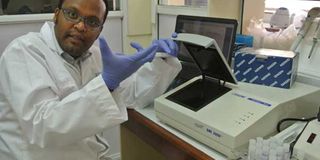Women can now carry out an HPV test from home

Sami Eldirdiri, Clinical Cytologist at KAVI explains how the Digital HPV testing machine works. A new technology that tests for the presence of the Human Papilloma Virus (HPV), which causes cervical cancer, has been introduced in Kenya and parts of sub-Saharan Africa. PHOTO | FILE
What you need to know:
- The test picks out the DNA of the sexually transmitted HPV to identify the presence of any of the 14 different high-risk strains of the virus, including type 16 and type 18 that cause cervical cancer.
- “Those who test positive for the virus will need regular monitoring by gynaecologists to see if they show signs of developing cervical cancer. Usually, this group is the minority, between seven and 15 per cent of all women,” said Dr Kalebi.
- Currently, pap smear and visual inspection are used to screen cervical cancer, but according to pathologists, neither tests for the presence of the virus like the Cobas HPV test.
A new technology that tests for the presence of the Human Papilloma Virus (HPV), which causes cervical cancer, has been introduced in Kenya and parts of sub-Saharan Africa.
The DNA-based test — Cobas 4800 — allows women to collect samples on their own for testing with the help of a device called an Evalyn brush, with which they swab the inner parts of the vagina.
According to Lancet Kenya group chief executive Ahmed Kalebi, the new “women-friendly, private, accurate and efficient” diagnostic test will enhance screening for the likelihood of a woman developing cervical cancer.
“Cobas 4800 makes it possible for women to collect samples for testing without the presence of a doctor or nurse,” said Dr Kalebi.
The test picks out the DNA of the sexually transmitted HPV to identify the presence of any of the 14 different high-risk strains of the virus, including type 16 and type 18 that cause cervical cancer.
If the results of the test are negative, the woman is categorised as being virtually at no risk of developing cervical cancer for three to five years, when it will be necessary for her to take a fresh test, unlike pap smear, which requires testing annually.
If the HPV viruses are found in the sample cells of the woman, she is then classified as being at high risk of developing cervical cancer and is referred to a gynaecologist where a pap smear test is conducted.
QUALITY PREVENTION MEASURES
“Those who test positive for the virus will need regular monitoring by gynaecologists to see if they show signs of developing cervical cancer. Usually, this group is the minority, between seven and 15 per cent of all women,” said Dr Kalebi.
The test was first approved two years ago by the US Food and Drug Administration as a primary screening tool for cervical cancer because it was found to be about 99 per cent accurate. Scientists said that the introduction of Cobas HPV as a primary screening test was informed by data from the 2011 Athena HPV study involving about 47,000 women aged 25 years and older undergoing routine cervical exams.
“One of the reasons women get diagnosed when cancer is in its advanced stages is that they tend to shy away from the invasive pap smear,” said Caroline Ng’ang’a, a cervical cancer survivor. “The Evalyn brush, however, does not distort this privacy, and is therefore highly recommended.”
Currently, pap smear and visual inspection are used to screen cervical cancer, but according to pathologists, neither tests for the presence of the virus like the Cobas HPV test.
“We have partnered with Lancet to provide the test kits at Sh5,000 to women who collect their own samples, which we take to the lab for testing,” explains Ms Ng’anga.
Cervical cancer is preventable and curable if detected early enough and treated correctly. However, the World Health Organisation says that, in sub-Saharan Africa, lack of effective screening and treatment policy, strategies and programmes have contributed to the high cervical cancer cases and deaths.
“With no access to quality prevention and detection services, most women seek consultation when the disease is already at an advanced stage,” the WHO states.
Although doctors in private hospitals have been using the Cobas test, governments are yet to introduce it in the public sector as a primary screening test.
At the same time, WHO’s guidelines for screening and treatment of precancerous lesions for cervical cancer prevention outlines three screening tests: an HPV test, visual inspection with acetic acid (VIA) and cytology (Pap test/Pap smear).
“All the three tests are complementary but this newly-introduced test will reduce the workload in hospitals, test more women and allow medics to concentrate on those who test positive for the virus,” said Dr Leah Kirumbi, a gynaecologist and researcher at the Kenya Medical Research Institute.



